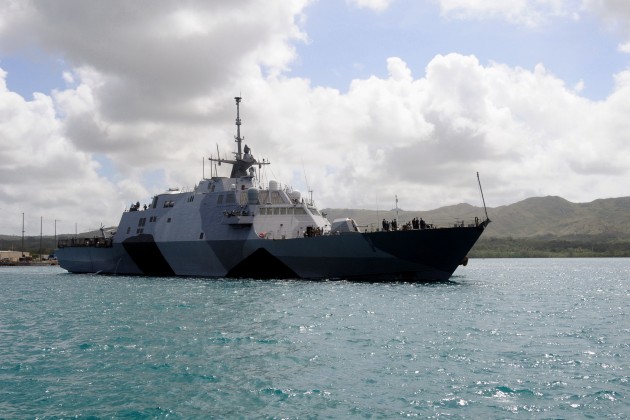Lockheed Says It Can ‘Easily’ Improve LCS
Posted on

The first Littoral Combat Ship, USS Freedom, on its way to Singapore last year.
ARLINGTON: In the race to replace the Navy’s controversial Littoral Combat Ship, the leading contender seems to be…. a better Littoral Combat Ship. That’s the clear implication of what we’ve been hearing from Navy leadership, and it’s clear from press briefings today that LCS contractor Lockheed Martin feels pretty confident it can do the job. (Lockheed builds the Freedom-class LCS; the Independence variant is by Austal and General Dynamics).
The incumbent’s advantage here is time. Lockheed VP Joe North told reporters at the companys pre-Farnborough Air Show briefing that he expects “every shipyard across Europe” to take a shot. But existing European designs might take years to revise to the US Navy’s requirements and an all-new design would take at least a decade. Of course, LCS is already in production, and while many in the Pentagon and Congress are deeply dissatisfied with the ship, Lockheed argues that its modular design makes it easy to upgrade.
“Whatever they decide they want for upgrades, they will start [putting on ships] as early as FY ’17 [fiscal year 2017],” North said of the Navy. Lockheed can meet that schedule or even beat it by putting upgrades on 2016 ships if desired, he said confidently. “I can easily work these [changes] in,” North said, and keep LCS production going without a pause: “If you do this right, we don’t need to break production. I think that’s huge.”
So what would the LCS-plus look like? “We gave them lots of options,” North said, “them” being the Small Surface Ship Combatant Task Force appointed by Defense Sec. Chuck Hagel to review alternatives to the existing LCS design; the SSCTF will report back to Hagel by August. Lockheed can build its LCS with a bigger main gun (“we’ve always been gun-agonistic,” North said), a more powerful radar, or a less zippy but more fuel-efficient power plant — all diesels instead of the current diesel-turbine combo — if the Navy decides long range is more important than high speed.
Perhaps most important, Lockheed can build an upgunned LCS with Vertical Launch Systems (VLS), the Navy’s plug-and-play launchers for a wide variety of missiles. The ship could accommodate eight VLS cell with a modest redesign to the bow, North told reporters, or up to 32 VLS if you cut the hangar capacity from two helicopters down to one. For comparison, the Navy’s cutting edge DDG-1000 Zumwalt destroyer, a vastly larger ship, carries 80 VLS cells.
What about survivability, though? The most common criticism of LCS — including by the Pentagon’s Director of Operational Test & Evaluation (DOT&E) — is that the hull is simply too fragile to survive in major combat. The Navy’s own rating system puts the LCS at survivability level one, compared to level two for the FFG-7 Perry-class frigates it replaces and level three for the much larger DDG-51 Arleigh Burke destroyers.
But in fact, “we’re more survivable than the FFGs,” North said bluntly. The Navy’s requirements for the various survivability levels have changed since the frigates were assessed, he asserted, and technology’s improved: “We’re using high-strength, low-weight steel that wasn’t even around.”
Subscribe to our newsletter
Promotions, new products and sales. Directly to your inbox.
